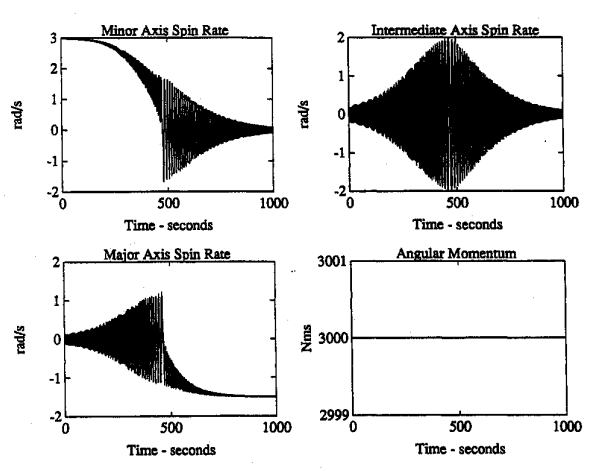In an article by Rahn and Barba, in which a flat-spin transition manoeuvre is investigated, the following figure is presented:
I'm trying to reproduce this figure by integrating the following coupled equations of motion stated in the article:
Using the following simulation parameters:
The angular momentum is calculated by:
The results:
Created by the following MATLAB code:
%%%%%%%%%%%%%%%%%%%%%%%%%%%%%%%%%%%%%%%
%%%%% Example Rahn & Barba (1991) %%%%%
%%%%%%%%%%%%%%%%%%%%%%%%%%%%%%%%%%%%%%%
% Principal moments of inertia of spacecraft including slug
Ix = 2000;
Iy = 1500;
Iz = 1000;
I = [Ix Iy Iz];
% Principal moments of inertia of spherical propellant slug
J = 18;
% Spacecraft body rates
omega_x = 0.1224;
omega_y = 0;
omega_z = 2.99;
omega_0 = [omega_x omega_y omega_z];
% Relative rates between spacecraft body and propellant slug
sigma_x = 0;
sigma_y = 0;
sigma_z = 0;
sigma_0 = [sigma_x sigma_y sigma_z];
% Viscous damping coefficient
mu_x = 30;
mu_y = 30;
mu_z = 30;
mu = [mu_x mu_y mu_z];
% Torques about principal axes
Tx = 0;
Ty = 0;
Tz = 0;
T = [Tx Ty Tz];
%%%%%%%%%%%%%%%%%%%%%%%%%%%%%%%%%%%%%%%
% Integrate system of differential equations
options = [];
[t1, x1] = ode45( @omega_dynamics, [0 1000], [omega_0 sigma_0], options, I, mu, T, J );
% Calculate angular momentum
h = ((Ix * x1(:,1) + J * x1(:,4)).^2 + (Iy * x1(:,2) + J * x1(:,5)).^2 + (Iz * x1(:,3) + J * x1(:,6)).^2).^(1/2);
figure(1)
% Plot minor-axis spin rate
subplot(2,2,1);
plot(t1,x1(:,3))
axis([0 1000 -2 3])
title('Minor Axis Spin Rate')
xlabel('Time - seconds')
ylabel('rad/s')
% Plot intermediate-axis spin rate
subplot(2,2,2);
plot(t1,x1(:,2))
title('Intermediate Axis Spin Rate')
xlabel('Time - seconds')
ylabel('rad/s')
% Plot major-axis spin rate
subplot(2,2,3);
plot(t1,x1(:,1))
title('Major Axis Spin Rate')
xlabel('Time - seconds')
ylabel('rad/s')
% Plot angular momentum
subplot(2,2,4);
plot(t1,h)
title('Angular Momentum')
xlabel('Time - seconds')
ylabel('Nms')
function dx = omega_dynamics(~, x_0, I, mu, T, J)
% Initial state vector
omega_x = x_0(1);
omega_y = x_0(2);
omega_z = x_0(3);
sigma_x = x_0(4);
sigma_y = x_0(5);
sigma_z = x_0(6);
% Constants
mu_x = mu(1);
mu_y = mu(2);
mu_z = mu(3);
Ix = I(1);
Iy = I(2);
Iz = I(3);
Tx = T(1);
Ty = T(2);
Tz = T(3);
% Differential equations
omega_dot_x = ((Iy - Iz)*omega_y*omega_z + mu_x*sigma_x + Tx)/(Ix - J);
omega_dot_y = ((Iz - Ix)*omega_z*omega_x + mu_y*sigma_y + Ty)/(Iy - J);
omega_dot_z = ((Ix - Iy)*omega_x*omega_y + mu_z*sigma_z + Tz)/(Iz - J);
sigma_dot_x = -omega_dot_x - mu_x*sigma_x/J - omega_y*sigma_z + omega_z*sigma_y;
sigma_dot_y = -omega_dot_y - mu_y*sigma_y/J - omega_z*sigma_x + omega_x*sigma_z;
sigma_dot_z = -omega_dot_z - mu_z*sigma_z/J - omega_x*sigma_y + omega_y*sigma_x;
% Return vector
dx = [omega_dot_x; omega_dot_y; omega_dot_z; sigma_dot_x; sigma_dot_y; sigma_dot_z];
end
As can be seen from the results, the angular momentum, which should be constant, is not constant, and even increases during the transition manoeuvre. I've checked my code up and down, but could not find any mistakes. I'm guessing it has something to do with the ode45 function, but I'm not sure. Does anyone here have a clue about what's going on?







ode45algorithm that causes this drift. $\endgroup$